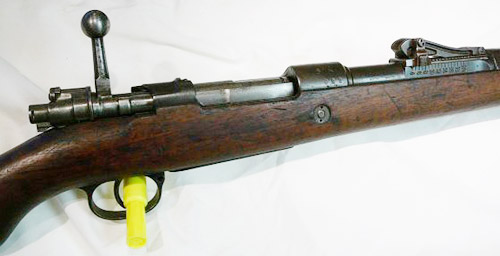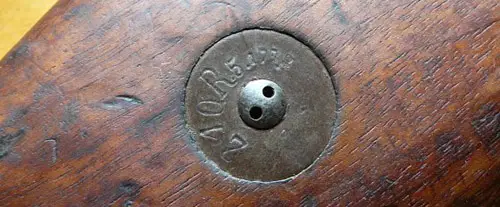|
Where It All Began: The Gewehr 98 Mauser Rifle By David Tong  The brothers Peter Paul and Wilhelm Mauser were probably the second-most prolific gun designers in history. Only John Browning can claim more designs going into series production. Paul Mauser was the main designer and he had developed for the German government, as well as other foreign countries, a series of turnbolt repeating rifles such as the Models 1891 Argentine, 1909 Argentine, Spanish 1893, Chilean 1895 and the Swedish 1896. Each can be considered a progressive development, in which the designer improved magazine design, the strength of the action, the method in which it cocked and user-safety features such as venting escaping gas from a blown primer or split case. In addition, his firm also
developed the cartridges that the rifles fired. These include the 7.65X53mm
Argentine/Belgian, the 7X57mm Spanish/Chilean, the 6.5X55mm Swedish and finally
the rifle we are examining here, the 7.92X57mm German Gewehr M1898. The Model '98
was a synthesis of all that had come before, the fully refined Mauser bolt
action rifle, in a package that is so revered that it remains the action that
modern sporting rifle enthusiasts and custom gunmakers prefer to this day. The action featured dual-opposed front locking lugs and a 2/3 cock-on-opening design. There was a third "safety" lug ahead of the bolt handle, full length �non-rotating� spring claw extractor (which affords both controlled-found feeding as well as great primary extraction), fixed blade ejector, rugged bolt stop, 5-shot staggered integral milled steel magazine box fed from stripper clips that allowed rapid reloading capability and a slightly conical breech to improve feeding. In addition, the M-98
incorporated gas-venting holes in the bolt body that direct gas downward into
the magazine and a gas deflecting flange on the bolt sleeve to protect the user
from a pierced primer sending back gas along the locking lug raceways. It is
said that Paul Mauser�s losing his sight in one eye was the impetus for all the
designed-in gas safety features. The rifle itself reflected
late 19th-Century military thinking. It is four feet, fourteen
inches in length, has a 29 inch barrel, weighs 9 pounds, has the famous Lange
rear sight graduated between 400 and 2,000 meters (known colloquially here as
the �roller coaster� for its shape) and a nearly full-length walnut stock with
upper handguard. The designers were addressing military concerns that the rifle
be useable with a fixed bayonet as a �pike� in hand-to-hand combat. In typical German fashion,
the rifle was serial numbered on all major parts including the buttplate, barrel
bands and bolt parts. It is rare to encounter a non-arsenal reworked rifle, so
most are mismatched. There were 11 armories dedicated to building Mauser 98's for
WWI, including four national armories and seven private factories. The rifle
pictured here was built by the Mauser factory itself in Oberndorf/Neckar during
1918, the last year of the war. The Gewehr (�rifle�) M-98 was
adopted by all branches of the German military in April of 1898 and it served
as standard issue for the Imperial German Army until at least 1924, when a
shortened Karabiner 98b was introduced. There are many anecdotal accounts of
the weapon�s reliability under extreme conditions, such as cold, mud and rain
in the World War I trenches, but there were also some criticisms. First, while trench warfare
was a nearly static affair, the minimum sight setting was problematic. Often
trench lines were not 400 meters away and thus shots fired would be high. A
field expedient was to file down the rear sight blade and deepen the rear sight
notch in order to lower the point of impact. Second, the length of the
rifle made it cumbersome on the rare occasions that troops would have to storm
the Allied trenches. Finally, while the rifle did generally acquit itself well
in the mud, the front locking lugs are pretty much buried within the receiver
ring and this can cause a cleaning issue that all rifles of the era, save the
rear-locking British Lee-Enfield, shared. The M-98 was so good that
the U.S., after having been roughed-up by the Mauser equipped Spanish in Cuba
when our Krag-Jorgensen service rifles were found wanting due to the inability
of our troops to rapidly reload them (due to not having a stripper clip feed
system), decided to build their own �98� style service rifle. Our resulting
1903 Springfield was so similar that Mauser sued the U.S. government over
patent infringements and the U.S. ended up paying a royalty to Mauser for each
rifle produced until our entry into the war in April 1917. My example has been in the U.S. a long time. There are no recent importer�s markings. It is not a matching numbers piece, but it has a matching barrel and receiver, headspaces correctly and has a reasonably bright bore indicating it was either used little or cleaned well after firing the corrosively-primed cartridges of the day. Post-WW I arsenal reworks often blued the originally �in the white� bolts and receivers and this is the case with my rifle. In addition, there is a �unit disk� on the right side of the butt stock. This provided identification of the rifle�s company or battalion and number. My understanding is that this practice was prevalent until about 1916 or so, when they were gradually phased out in favor of a semi-conical steel disk with a hole drilled through its center, to allow the rifleman to disassemble the firing pin from the field-stripped bolt. Thus, the stock may not be �correct� for my 1918 rifle, but is certainly designed for this model rifle.  I must admit that I have not yet shot this one yet. 7.92mm �JS� rounds featured a 198 grain FMJ spitzer bullet that leaves the barrel at approximately 2,500 feet per second. This, along with the elderly stock design, generates some recoil that is not at all mitigated by the steel buttplate, which is better for bashing in someone�s skull than ensuring shooting comfort! I find the rifle clumsier and harder-recoiling than the British Lee-Enfield, and the Germans found, to their chagrin, that not only did the British rifle use similar stripper clips to reload their rifles, the Enfields also had a 10-shot magazine and a generally smoother action, even though the British piece requires more effort to close. (It cocks the striker on closing). Matter of fact, early war after action battle reports indicated the Germans sometimes believed that they were encountering British machine gun fire because of the training the Brits gave their line companies. All said and done, while the British may (arguably) have made a better combat weapon, it is the German rifle and its derivatives (which include the famed Winchester Model 70 and the Remington Model 798) that has been the design that has endured. FN of Belgium simply usurped the design after the German defeat and built them in huge quantities for the sporting trade, including Browning Arms. The Mauser 98's qualities are unlikely to be surpassed for the cartridges it is capable of handling. This is why most knowledgeable rifle users insist upon a Mauser-type design to this day; another example of how military technology was co-opted by the civilian sporting trade based upon the experiences of returning troops. |